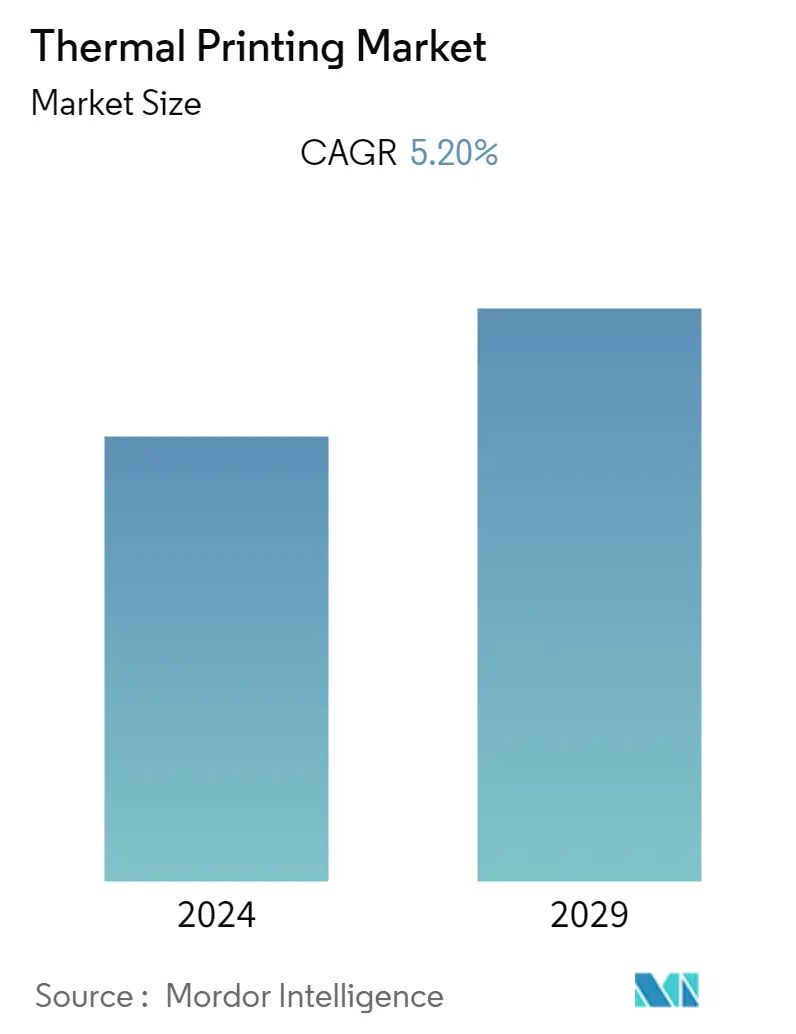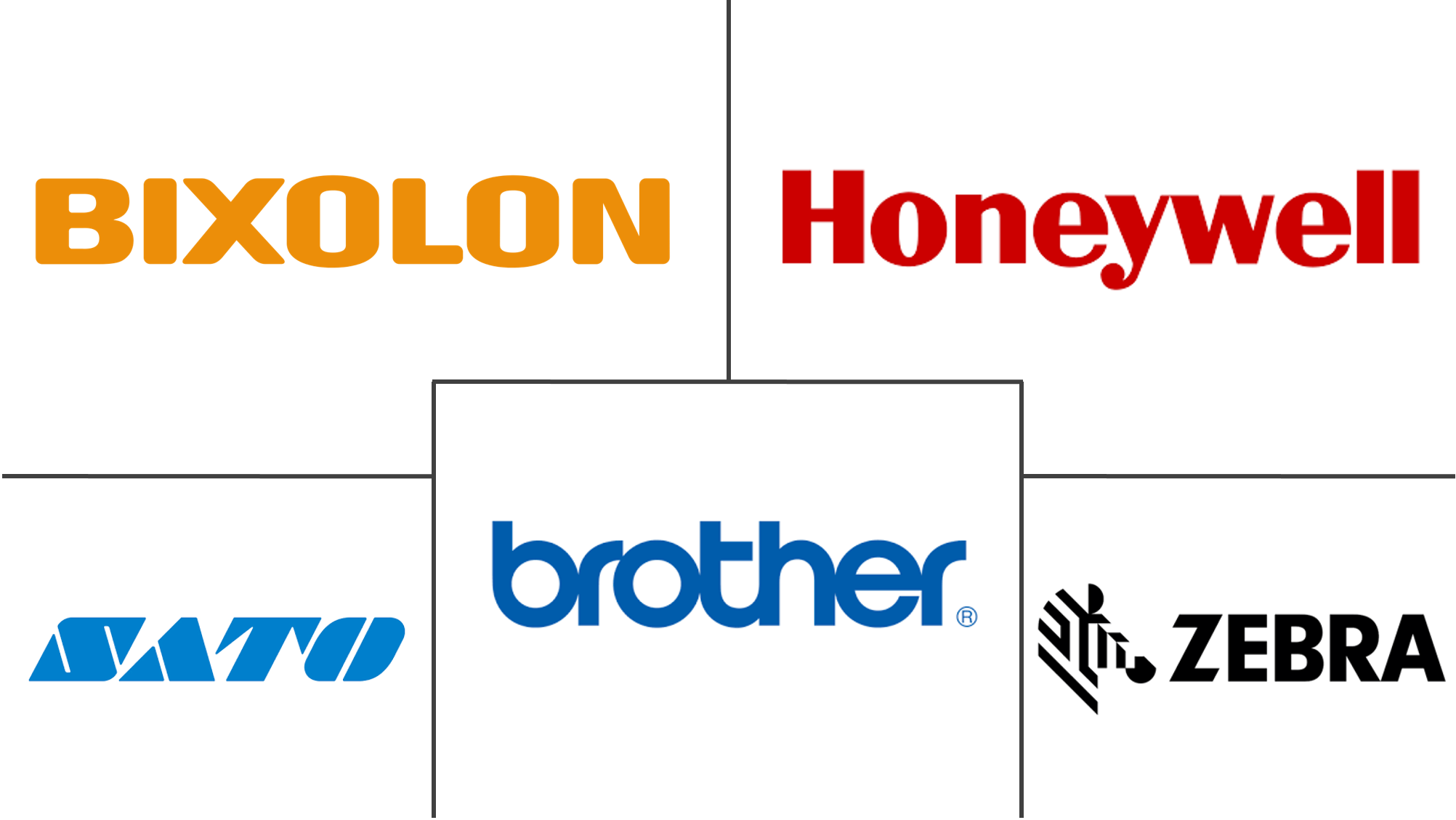Market Size of Thermal Printing Industry

| Study Period | 2019 - 2029 |
| Base Year For Estimation | 2023 |
| CAGR | 5.20 % |
| Fastest Growing Market | Asia Pacific |
| Largest Market | North America |
| Market Concentration | Low |
Major Players
*Disclaimer: Major Players sorted in no particular order |
Thermal Printing Market Analysis
The Thermal printing market is excepted to register a CAGR of 5.2% during the forecast period. The growth of demand for thermal barcode printers in the supply chain process is increasing effectively along with growing concerns about product safety and anti-counterfeiting, along with the rising use of thermal printing technology in the most recent on-demand printing applications leads to driving the demand for the market.
- The industry is driven by introducing AIDC (Automatic Identification and Data Capture) technology to increase work rates. Businesses can save and retrieve much information about the product that a barcode is on, thanks to barcodes. They are commonly used in medical and hospitals to identify patients and access information on medical histories, medicine allergies, and other crucial details.
- Moreover, when needed, especially in an emergency, the usage of smart labels aids in the immediate tracking of patients and medical equipment. Labels and tags compatible with numerous operations in the healthcare industry are frequently printed using thermal printers, which helps to increase patient flow, bed utilization, and asset allocation.
- The growing use of wireless technology in portable printers has driven the market. Device manufacturers are turning away from the current all-in-one type of mobile information devices (handheld terminals) due to the widespread use of PDAs (Personal Digital Assistants), which can communicate with PCs and be controlled commercially.
- Further, Examples include applications that require high-resolution text or graphics in small-format output (2.9"x4.1" or 4.1"x5.8") and the ultra-slim, a lightweight mobile printer from Brother. The MW Series provides simple, wireless communication with iPhone, iPad, iPod, Windows, Windows Mobile, and Android devices thanks to MFi Bluetooth wireless technology and universal operating system compatibility. Furthermore, Bluetooth-enabled phones can communicate with wireless printers within 33 feet via radio frequency at 2.4GHz.
- However, there are drawbacks to these printers, too, as the extra heat from this printing frequently damages the print head and raises the cost of repair and replacement.
- Moreover, almost every industry has been negatively impacted by the COVID19 problem, which has disrupted supply chains, nationwide lockdowns, and organizations considering the idea of long-term or even permanent remote working. Many businesses are currently adjusting to account for Covid-19's complex and wide-ranging consequences on the print industry.
Thermal Printing Industry Segmentation
Thermal printing is a digital process that uses heated, coated thermochromic paper or thermal paper to produce printed images. In many small, medium, and large enterprises, barcode, and label printers are primarily used to mark and track the products sent. These industries include retail, healthcare, supply chain, and others.
The Thermal Printing Market has been Segmented by Printer Formates (Barcodes, Labels, POS (Point of Sale), Technology (Direct Thermal, Thermal Transfer), End-Users (Retail, Healthcare, Industrial & Manufacturing, Transportation, Government), and Geography.
| By Printer Format | |
| Barcode | |
| Label | |
| POS (Point of Sale)/ Kiosk | |
| Other Printer Formats |
| By Technology | |
| Direct Thermal | |
| Thermal Transfer |
| By End-User | |
| Retail | |
| Healthcare | |
| Industrial & Manufacturing | |
| Transportation | |
| Government | |
| Other End-Users |
| Geography | ||||||
| ||||||
| ||||||
| ||||||
| Latin America | ||||||
| Middle-East & Africa |
Thermal Printing Market Size Summary
The thermal printing market is experiencing significant growth, driven by the increasing demand for thermal barcode printers in supply chain processes and the rising concerns about product safety and anti-counterfeiting. The adoption of Automatic Identification and Data Capture (AIDC) technology is enhancing work efficiency, particularly in sectors like healthcare, where thermal printers are used to print labels and tags for patient and medical equipment tracking. The integration of wireless technology in portable printers is further propelling market expansion, as device manufacturers shift towards more versatile solutions like Personal Digital Assistants (PDAs) that offer seamless communication with various devices. Despite the advantages, challenges such as print head damage due to excess heat and the lingering impacts of the COVID-19 pandemic on supply chains and remote working arrangements pose obstacles to market growth.
North America holds a dominant position in the global thermal printing market, largely due to the region's robust retail, transportation, logistics, and healthcare sectors. The transition from impact printers to thermal-only alternatives is prevalent among North American retailers, driven by the need to reduce costs and environmental impact. Key players like Zebra Technologies, Honeywell, and Avery Dennison are instrumental in this growth, offering a wide range of thermal printing solutions. The market is highly fragmented, with numerous global and local players innovating to enhance work efficiency across various industries. Recent strategic moves, such as Zebra Technologies' acquisition of Matrox Electronic Systems Ltd., highlight the ongoing efforts to expand offerings in automation and vision technology, further fueling market expansion.
Thermal Printing Market Size - Table of Contents
-
1. MARKET DYNAMICS
-
1.1 Market Overview
-
1.2 Market Drivers
-
1.2.1 Adoption of Automatic Identification and Data Capture (AIDC) Technologies for Productivity Improvement
-
1.2.2 Increasing Adoption of Wireless Technologies in Mobile Printers
-
-
1.3 Market Restraints
-
1.3.1 High Repair and Replacement Costs
-
-
1.4 Value Chain Analysis
-
1.5 Industry Attractiveness - Porter's Five Force Analysis
-
1.5.1 Threat of New Entrants
-
1.5.2 Bargaining Power of Buyers/Consumers
-
1.5.3 Bargaining Power of Suppliers
-
1.5.4 Threat of Substitute Products
-
1.5.5 Intensity of Competitive Rivalry
-
-
-
2. MARKET SEGMENTATION
-
2.1 By Printer Format
-
2.1.1 Barcode
-
2.1.2 Label
-
2.1.3 POS (Point of Sale)/ Kiosk
-
2.1.4 Other Printer Formats
-
-
2.2 By Technology
-
2.2.1 Direct Thermal
-
2.2.2 Thermal Transfer
-
-
2.3 By End-User
-
2.3.1 Retail
-
2.3.2 Healthcare
-
2.3.3 Industrial & Manufacturing
-
2.3.4 Transportation
-
2.3.5 Government
-
2.3.6 Other End-Users
-
-
2.4 Geography
-
2.4.1 North America
-
2.4.1.1 United States
-
2.4.1.2 Canada
-
-
2.4.2 Europe
-
2.4.2.1 United Kingdom
-
2.4.2.2 Germany
-
2.4.2.3 France
-
2.4.2.4 Rest of Europe
-
-
2.4.3 Asia-Pacific
-
2.4.3.1 China
-
2.4.3.2 Japan
-
2.4.3.3 India
-
2.4.3.4 Rest of Asia-Pacific
-
-
2.4.4 Latin America
-
2.4.5 Middle-East & Africa
-
-
Thermal Printing Market Size FAQs
What is the current Thermal Printing Market size?
The Thermal Printing Market is projected to register a CAGR of 5.20% during the forecast period (2024-2029)
Who are the key players in Thermal Printing Market?
Zebra Technologies Corporation, Sato Holdings Corporation, Honeywell International Inc., Bioxolon and Brother International Corporation are the major companies operating in the Thermal Printing Market.

